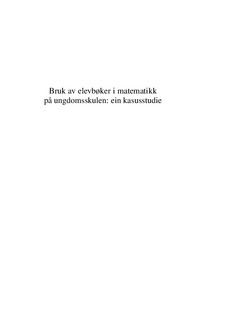| dc.description.abstract | The focus of this dissertation is on ways students and teachers work with
the student-book in mathematics in lower secondary school. The
intention is to study how it is integrated to the learning activity in the
subject. The student-book in mathematics was introduced at the end of
the 90s. It was depict as a pedagogical tool, mainly in the learning
process for the individual student (Eksamenssekretariatet, 2000), by
giving the students the opportunity to take responsibility for their own
learning.
This study is part of a larger research project on classrooms, Kvalitet
i opplæringa (KIO) (Quality in education), led by Peder Haug from 2007
to 2010. Both quantitative and qualitative data are used; these are mainly
from questionnaires and interviews of teachers and students. A total of
282 students have responded the questionnaire and 14 students have
been interviewed. A total of 73 teachers have responded to the
questionnaire and two of them have been interviewed.
In this study the introduction of the student-book is related to the
theory of writing to learn mathematics (Morgan, 1998). In order to
systematise the analysis and understand the data, activity theory has been
used (Engeström og Miettinen, 1999) in combination with Sfard’s
commognition theory (2008).
A distinction between the student-book as a tool on tests and as an
artefact in the learning process of mathematics has been made in the
analysis. The mathematical activity at school, according to the teachers
and students, starts with an introduction of the theme in class and
afterwards the students are solving tasks from the textbook. It is mainly
when new subjects are introduced, at the beginning of the lessons that
the students work with their student-book. Many students reveal that
their writing in it is mainly copied from the board and subject the
teachers dictate when they introduce them to new themes.
Based on the distinction between presentation writing and reflective
writing made by Hoel (2008), the students are mainly producing
presentation writing. Here the focus is on the final product which would
be presented to others, while in reflective writing the focus is on the
writing as thinking aloud on paper. I use the term product writing,
instead of presentation writing, since the focus is on making the best
possible aid on tests. Therefore, the term product writing is better suited
to covering the writing the students perform when the focus is on the
final product.
In this study a distinction has been observed between the intentions
with the introduction of the student-book in mathematics and how it is
implemented by most teachers. Letters from the Eksamenssekretariatet
(2000) indicate that the content in the student-book should be the
Bruk av elevbøker i matematikk på ungdomsskulen: ein kasusstudie 8
student’s self-made reflections and summary of the subjects. From the
analysis, the first conclusion is that the introduction of the student-book
in mathematics has not led to any changes in the actions performed by
students in the learning processes of mathematics. Another conclusion is
that writing to learn is not a procedure which has been identified as
commonly used in the mathematics. The writing produced in the studentbook
is mainly in the recount and summary mode as Clarke, Waywood
and Stephens (1993) found in their study. Most students are not writing
their own preparations and reflections on mathematics, as was the
intention with the student-book when introduced. They are not,
according to these researchers, creating and shaping knowledge. One
explanation for this is probably related to the limited time used on
writing in the student-book.
From an implementation perspective (Fullan, 1992) it can be
concluded that the student-book is not implemented as suggested by the
official document in the mathematical activity in lower secondary
school. Most of the students have not made use of writing in the studentbook
to learn mathematics. In this way my study can also provide an
important contribution to the discussion about how to integrate new
elements in the mathematical activities in the school system. | no_NO |
